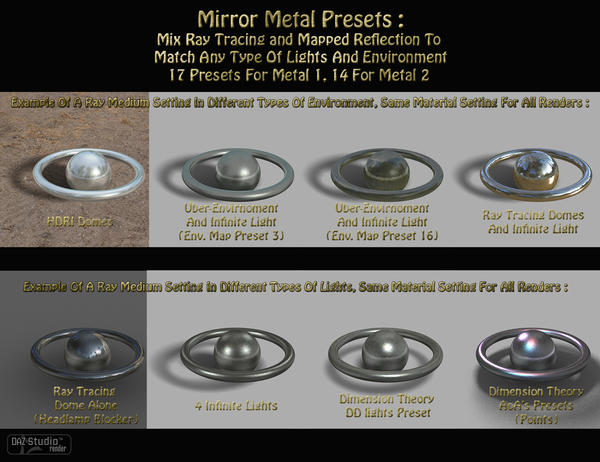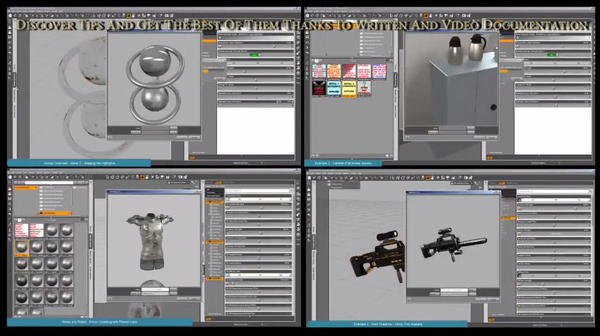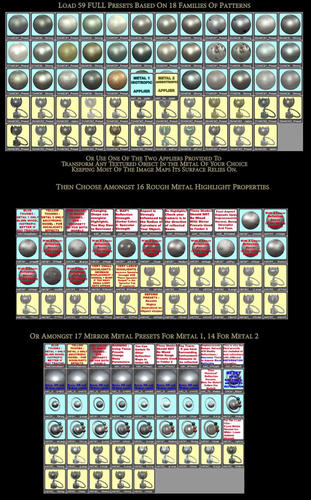Released : Advanced Metal Creator (Shaders - Merchant Resource) [Commercial]
 V3Digitimes
Posts: 3,216
V3Digitimes
Posts: 3,216
Released today! They are here :
http://www.daz3d.com/new-releases/advanced-metal-creator
The ReadMe is here and contains a more detail description :
http://docs.daz3d.com/doku.php/public/read_me/index/19362/start
There's a pdf downloadable at the end of the readme you can rely on, but you can ask anything you want here too.
They belong to the "spacing out" discounts of the day, don't ask me why. Because sci fi world is metallic? Maybe.
Feel free for any questions, concern, feedback in this topic :)
Advanced Metal Creator is made of 2 new material type, dedicated to metal creation and rendering, and much more. They come as appliers (replacing any of your existing material by one of the two metal models), as presets already set up with maps and properties, and with more than one hundred sub properties presets in term of highlights, displacements and reflection characteristics, all organised in subfolders, as well as with a strong pdf and video documentation to obtain the best out of them. To be more easy, you can load directly the pdf (34 pages) and the video documentation (more than 4 hours on youtube in 7 videos) from the product content library.
Why Rendering?
Because rendering of metal is extremely difficult in DAZ Studio, not because of the software, not because of the render engine, just because the parameters required for metal creation are "by default" not included in DAZ default material.
AMC not only add these features, but they do so in two different ways, one isotropic with a double control of highlight sizing via two parameters, and one anisotropic with direct sizing of the highlights on two perpendicular directions, independently of the UV map. For the last one, two more parameters are included in order to change the shape of the highlight.
Why Creation?
Because it is also a merchant resource, meaning that you can re-use the shaders presets, the shaders themselves and pick up any of the 177 (YES, 177!) image maps included in the 3D assets you are creating and selling. The rules of the game will be detailed in the readme.
Why Advanced ?
Because the new metals created include all the additional features you need to manage great metal creation and rendering :
- Surface deformations - fundamental in metal identification by the human brain - are divided in 5 layers, one bump, one adjustable normal, 3 displacement (one for texture, one for defect, one for additional patterns),
- BRDF included in specular give a strong controls over the highlight, so important in metals too,
- You can drive the mix of ray traced and mapped based reflection in order to adapt your metals to the different scene condition (lighting, environment and props to reflect or not...)
- You can switch between hundreds of sub-properties,
- And much more but I stop here the description since too long posts are not read! ;)
A rapid video here: http://youtu.be/eiu_jtGbfh8
(For the ones who want to see what anisotropy does, in the first seconds of the video, look at the highlight deformation on the metal and not on at the titles...)










Comments
So are these only for merchants to use to create items to sell or are they shaders that non-merchants will get use out of?
Of course they are shaders that everybody can use the way they want, even for rendering only. You just select a surface, double click on the shader of your choice, and this is done.
They do not differ in term of use from the shaders generally available, but now you have furthermore the right to sell materials, props and shaders made out of them.
They are initially just metal shaders, but after speaking with other PA, a lot of them felt like having this weapon in their arsenal, since it is so difficult to make something rendering really like a metal, which is normal because DS Default material does not include from start the required features to do so (features which I included in these two shader types - by shaders is the way the render software will interpret the different data, included in my case in a brick network).
That's why I made a content resource so that any content creators will be able to re-use and sell them in their content, because it is so frustrating to create a great metallic prop and not managing to have it well rendered.
That's done! They are here!
This looks really great :) I admit I have a few questions however - I am not very technical and kind of easily confused - I have your earlier metal and wooden shaders, was wondering if that metal shader is different than this product?
I was not aware that shaders couldn't be used to create models for selling - now that I think about it, I am not sure how that would work anyway.
If you create a model in a modelling app, and add UVs - then import it into DS and texture it - you could not export it and sell it as is? If, for example, I created a piece of clothing and textured it with fabricator, then gave it away as a freebie or sold it, this would not be allowed? I imagine anyone using this model would need to have fabricator in order to see that texture...
So I would have to use special sets such as this one to create models textured with shaders to sell or give away? And, if I purchased this set, and textured my model in DS, would it then export with everything intact? Would someone using the model need to have your metal creator also? Would it work in Poser or say with Lux? I suppose I shouldn't be even asking any of this since it's probably over my head, but I hadn't realized you needed a merchant resource licensed shader to create models). Thanks for taking time to answer this :) -Cathy
Of course you could sell as is if you create your own material and/or use daz default material : because you are only using "built in content". Concerning the fabricator, I could not tell you, I have never had a look at the licence of it. But I would say,I'm not sure I don't know well this product, maybe when you sell a fabricator file, you do not sell the work of the author of the fabricator (which is the fabricator itself), but your own work. Fabricator is a tool, metal shaders are shader. The value of a tool is in the tool itself, which you do not distribute, the value of a shader is the shader itself... arg, this is hard to be clear...
Yes, you need to own the rights to resell the content. Sometimes the rights are obvious (Daz lights, daz default materials), sometimes they are acquired, that is what the merchant content is here for.
Yet my merchant ressource, as many merchant contents, is not to give away, it is dedicated for sell as mentioned in the ReadMe (http://docs.daz3d.com/doku.php/public/read_me/index/19362/start), this is a protection, otherwise, it would be too easy to find the full product entirely free for download for everybody in the blink of an eye. (which is already the case with piracy you will tell me!).
Nobody needs the metal creator to have it working. I made it so that you can save them as materials, or as shaders, or in props directly, and the parameters of these new materials are automatically integrated in the files. You just need DS4.6. The only thing is that it could not work in DS3 since the functions involved did not exist on DS3 time.
It would not work in poser since the special shader bricks involved are not automatically transfered from daz to poser. Only the parts relying on the default base might be transfered, yet you could re-create the material in poser material room.
Concerning lux, I have not tested. It probably depends on "how" the luxrender transfer pluggin catch the map and parameters. What I did is that I built the shaders "surrounding" the default material. So I guess transfer softwares should catch everything which has kept the same parameter name as the default parameter name, meaning most of them. Yet for instance it would not be directly possible to load the three layers of displacements, but this should be checked. You should keep diffuse, ambient, reflection, basic displacement (but not the other layers), normal maps and strengths. Yet you can probably replug the 2 missing displacements maps in octane, for lux, I would recommend to merge all the displacement map files used in photoshop, and re-apply them as main displacement, before export to lux.
I'm sorry I have not answered before, I hope it is ok for you, please tell me if you have other questions.
Thanks so much for your answers to my questions! Sorry to have had so many, your new product just brought up to me things I had been unaware of - it is really not likely that I will create any models any time soon, but I had never realized that this was a consideration. Thanks also for the explanation as to why using merchant resources on freebies is not allowed, I hadn't even thought about that making it possible to then give away the merchant resource free.
I appreciate so much all the work you've put into creating these shaders, they are complex and wonderful :) -Cathy
.... YOU don't think about that... But some people could ;) It's a matter of honesty and respect.
Well, let's say there is enough illegal piracy, it would be crazy to organise a "legal" one...
Is this product shader-mixer based?
Yes it is, and you can even adjust things in the brick network if you feel like customising it to your needs.